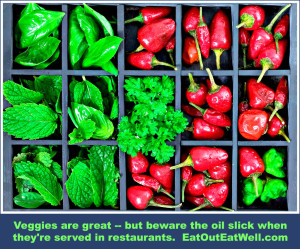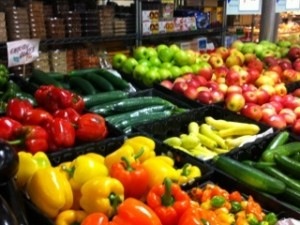 Welcome to week #2 of the lose a pound a week challenge. This week’s tips focus on how to save calories when you eat out.
Welcome to week #2 of the lose a pound a week challenge. This week’s tips focus on how to save calories when you eat out.
Are you afraid to eat out for fear of “blowing your diet” or because you think there aren’t good choices to be had? Are you tired of hearing that you shouldn’t go to restaurants if you want to control what you eat?
Choices
You can choose to eat out and eat well. It’s all in the choice that you make.
Your first choice is when you select which restaurant to go to (do you want grilled fish or a huge plate of pasta). The second round of choices come when you’re inside the door and confronted with the menu, the breadbasket, and the portions.
No Trauma
Don’t let the thought of eating out be traumatic. Restaurants exist to serve you meals and it is up to you to choose which one to go to and what you will eat when you get there.
Eating well and eating lean does have to be complicated. The simpler the better.
Make sure you have lean protein from meat, fish, vegetable, dairy, or grain sources. Look for healthy fat sources like olive oil and avocado. Grains should be whole grains. Aim to fill ½ to ¾ of your plate with food from plants.
If you’re not certain how something is prepared or would prefer to have something that is prepared differently, just ask. Most restaurants are accommodating when asked nicely (and not at their busiest hour). They might even suggest something that is not on the menu.
Week 2, Tip #1: Vegetables Are Amazing But Beware The Oil Slick
Steamed veggies may not always be the most delicious. To make them taste better, chefs often finish them off with butter or rinse them with oil to amp up flavor before they’re brought out to your table (and the sheen from the fat makes them look prettier). Sometimes veggies and salads are tossed with bacon or bacon drippings to make them taste good — but without mentioning it on the menu.
Softer vegetables like mushrooms, or veggies with soft insides, like eggplant, absorb more fat than harder vegetables like sweet potatoes, beets, and parsnips.
You can always ask to have your vegetables served “dry” or look for pickled vegetables – they’ll be higher in sodium, but low in fat.
And remember, you also always ask if you can substitute a vegetable for potatoes, rice, or pasta. Most restaurants will agree.






